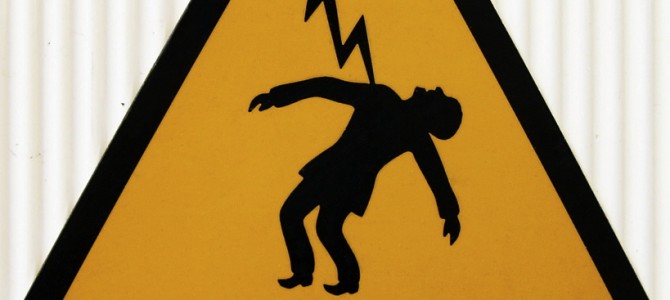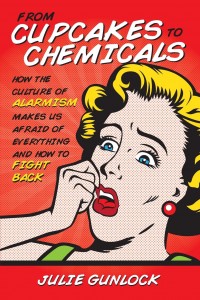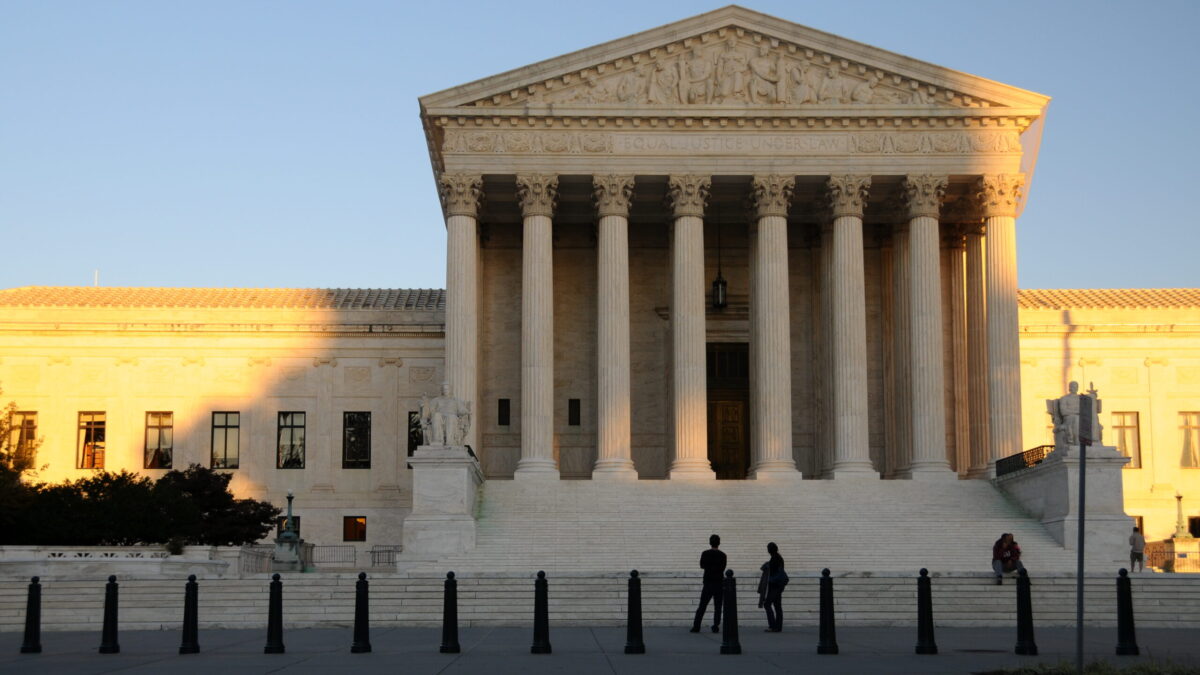
From the book, Cupcakes to Chemicals: How the Culture of Alarmism is Making us Afraid of Everything by Julie Gunlock. Reprinted by arrangement with IWF Press. All rights reserved.
A few years ago, I was watching the news and was shocked to learn that my garden hose was incredibly dangerous.
Say, what?
The newscaster anchoring the program that night seemed really upset about this story. He leaned forward in his seat, stuttered… and…wait…did I see him tear up? Did his voice just crack? Oh my gosh, he’s going to cry!
This.is.a.serious.problem.
SOMETHING MUST BE DONE! NOW!
It’s weird. I sometimes fall for it. I know I shouldn’t but sometimes…only once in a while…I forget and fall into the alarmist trap. These news anchors seem so eager to protect me, so gallant, with such nice hair and skin. They look like they smell really good and take care of their teeth. They are genuinely concerned for my kids. I think they like me. I bet they’d want to hang out…
And then I snap out of it and remember that this is all part of the plan to freak me out so that I will welcome, even demand, the guiding hand of government. The alarmists and their media pals know that as a mom, I’m vulnerable to this type of messaging. They hope for this type of reaction: outrage, horror and fear.
 Yet the real facts behind the “killer garden hoses lurking in your backyard” are hardly scary. The news story centered on the fact that most garden hoses are made of polyvinyl chloride, better known as PVC. PVC has high levels of lead and other chemicals and, therefore, the claim was that since children and pets sometimes drink from garden hoses, they were getting big doses of toxins when taking the occasional sip.
Yet the real facts behind the “killer garden hoses lurking in your backyard” are hardly scary. The news story centered on the fact that most garden hoses are made of polyvinyl chloride, better known as PVC. PVC has high levels of lead and other chemicals and, therefore, the claim was that since children and pets sometimes drink from garden hoses, they were getting big doses of toxins when taking the occasional sip.
But before you read anymore, just think about it: Do children and pets really drink a lot of water from garden hoses? Is the garden hose a main source of water for children and pets? Are they drinking gallons of water this way?
Sure, during summer months, kids consume some “garden hose water” as they play in the sprinkler or splash in the kiddie pool. They may take a gulp or two when mom’s watering the garden. But in general, kids do not get the bulk of their water in any given day— much less during their lives—from the garden hose. After all, the alarmists also tell us that kids drink too much juice and soda, and we know that doesn’t come out of a garden hose.
I was lucky that I had time to look into this story and question its merits. I was able to ignore the hysteria, and consider the facts. And those facts are reassuring. Most garden hoses are indeed made of made of polyvinyl chloride, which is toxic if consumed in large quantities. Yet, it is impossible—let me repeat that word, impossible—for a human to consume enough water to reach toxic levels of PVC exposure. Why is this impossible? Because the amount of chemical that leaches into the water is so miniscule that a person would have to consume massive amounts of garden hose water in order for it to be a problem. And if a person attempted to drink the amount of water required to reach PVC toxicity, they’d first die of dilutional hyponatremia—death by water overdose—before reaching that toxic level.
In other words, you simply cannot poison yourself with garden hose water. You cannot harm yourself by the occasional sip of garden hose water. Again, it’s impossible.
Alarmists naturally ignored this common sense and called for regulations on the garden hose industry. One terrified mommy blogger wrote: “I can’t tell, looking at a hose, whether or not it is safe. Only a large scale overhaul of the regulations that govern what chemicals get into our stuff, such as the Safe Chemicals Act, can begin to protect us.” But so far manufacturers of garden hoses have been allowed to carry on with their businesses without having to jump through any new regulatory hoops.
But this doesn’t mean there isn’t a cost. Right now there are moms out there who are sitting on patios watching their toddlers run through the sprinkler or jump in the kiddie pool who are filled with fear of their garden hose. You can almost envision the scene: Instead of just enjoying the moment watching their kids play and laugh and work off some energy, these moms are periodically stopping to pester junior not to drink through the hose. The kids probably won’t listen and will drink the water anyway, so then mom will become angry and begin yelling.
Ultimately, she’ll be left feeling defeated, worried, and scared. The kids will also feel bad, not enjoying the play as much and may even feel vaguely worried that they’ve endangered themselves. That may not impact the national economy, but it is making the country a worse place to live.
But these activist organizations don’t seem to care that the anxiety level in this country is already off the charts. These groups understand that nervous parents are powerful allies in the effort to have manufacturers add warning labels to nearly every product they produce.
Yet, parents should also understand these warning labels come at a high cost to their bottom line because when the government mandates that a manufacturer alter its packaging or manufacturing practices, the costs associated with the changes aren’t simply absorbed by the company. Rather, the costs are passed to consumers, most of whom never asked for these changes in the first place.
We Need A Warning Label On Warning Labels
And while the alarmists like to say, unreservedly, that nearly everything sold in the grocery stores should come with a large warning label—on the front of the package—reasonable parents know these labels do next to nothing to protect children, especially as warning labels become so ubiquitous people inevitably tune them out.
Consider what is now being labeled a threat to our children. In 2010, the American Academy of Pediatrics (AAP) announced that “high-risk” foods like apples, chewing gum, chunks of peanut butter, hard candy, marshmallows, nuts, popcorn, raw carrots, sausages, seeds, grapes, and hot dogs should come with a warning label. The idea wasn’t that there were nutritional problems with these items, but the AAP wanted parents warned that these foods posed a choking hazard to young children.
But is choking as big a problem as the AAP portrays it to be?
According to the Centers for Disease Control, 134 children under the age of four (that’s the age range that children are most at risk for choking on food) died of suffocation in 2011. That’s .0000556 percent of all children in this age range. To put that rather hard to fathom fraction in perspective: Your child is four times more likely to be struck by lightning (.0002 percent) than choke on his food. And not all of those asphyxiation deaths were caused by food. In fact, according to the CDC data, only 25 percent were caused by food being lodged in the airway. The other 75 percent of deaths were the result of accidental hangings, choking on non-food items, suffocating on bed sheets or unspecified problems with breathing. While the death of any child is tragic, we need some perspective: Choking deaths among children are rare, and choking deaths caused by food are even more rare.
Yet, this reassuring data hasn’t stopped the AAP demanding food manufactures add warning labels and “redesign” certain food items, such as hot dogs, so the size, shape and texture make them less likely to lodge in a child’s throat. Janet Riley, president of the National Hot Dog and Sausage Council (uh, yes, this organization actually exists), injected a little bit of common sense into the great “hot dog reshape” debate saying:
As a mother who has fed toddlers cylindrical foods like grapes, bananas, hot dogs and carrots, I ‘redesigned’ them in my kitchen by cutting them with a paring knife until my children were old enough to manage on their own.
But relying on a parent’s common sense simply isn’t good enough for alarmists like Dr. Gary Smith, the lead author of the AAP statement, who said in a “USA Today” article that “No parents can watch all of their kids 100% of the time…The best way to protect kids is to design these risks out of existence.”
He’s correct. Parents simply cannot be expected to watch children 100 percent of the time, and this does indeed leave children vulnerable to dangers. Yet, Smith’s simplistic solution to “design risks out of existence” is unrealistic and incredibly naive. How will we rid the world of stones? Coins? Marbles? The keys off of the computer keyboard that my industrious two-year-old once pried out to pop in his mouth? Does Dr. Smith suggest we place children in a bubble to keep them safe from every possible environmental danger?
After all, young children face far greater risks than choking. In fact, a far greater cause of injuries among children (0-14) is falling down—a pretty common occurrence among humans learning to walk and run. The CDC estimates that about 2.8 million children go to the emergency rooms each year because they fall down and hurt themselves. In Dr. Smith’s super safe world stairwells would be banned, high surfaces made illegal and common items in a home—like tables and bookshelves—gathered up and destroyed. What else Dr. Smith would like to see “designed out of existence?”
A better solution might be for the AAP to advise parents to look at a food and determine for themselves its choking potential. Perhaps the AAP could remind parents to tell their kids to eat slowly, take smaller bites and chew. Unfortunately, personal responsibility isn’t enough for your benevolent government minder who thinks you’re an idiot.
Again, common sense isn’t the only casualty here. Dr. Smith and his colleagues at the AAP seem not to understand this, but industry will need to spend money—money that could go to job creation, bonuses for employees, or the creation of other, perhaps healthier, products—on redesigning foods to suit their nanny predilections.
Life Is Risky
Of course, we all want to reduce risks for our children. Yet life itself comes with a certain amount of risk and it’s the job of competent adults to mitigate life’s risks and to teach children to do the same. Learning how to handle life’s risks is critical to human development, and it would be a problem if parents failed to teach children how to assess risks on their own.
After all, there’s no need to advise your child to chew food completely before swallowing if all food is redesigned to prevent choking. You don’t need to tell your kid to stop climbing on high spaces if there are no high spaces to climb. If we do away with cars, there’s no need to tell the kids to look both ways when you cross the road… and on and on. Reasonable people understand that eliminating all risk during childhood isn’t possible, and wouldn’t even be desirable if it was possible.
Parents want information so that they can make good decisions for themselves and their families. They should reject those who en- courage them to worry about everything under the sun (speaking of that scary, dangerous sun…). It’s not healthy for them, and it’s not healthy for children.
Occasionally, parents should even sit back and appreciate how we are all extremely fortunate to be raising our kids in the modern era where common diseases have been eradicated, child death is rare and modern conveniences make our lives not just easier, but a lot more fun. We should protect our children from true dangers, but not get so overwhelmed that we forget to enjoy life. In fact, I would say the destructive alarmist culture is one aspect of the modern world that you really should try to keep away from your family.
Follow Julie on Twitter.








